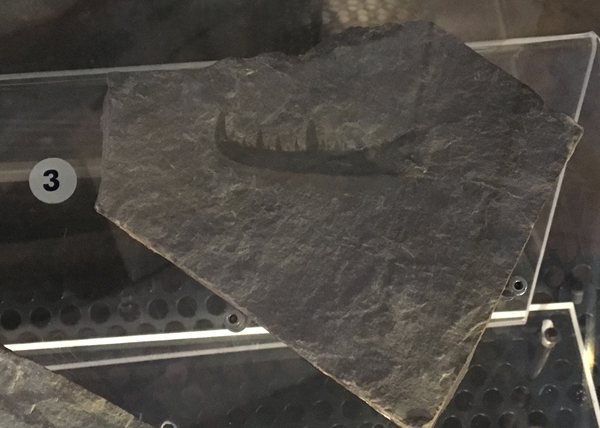The fossil record is rich and diverse however, it only represents a tiny fraction of all the life that has ever existed on Earth. In addition, some fossils can be easily confused and misinterpreted, for example, we recall an incident that occurred when visiting the National Museum Cardiff (Wales). We overhead a conversation in the Evolution of Wales gallery, a mother was pointing out a dinosaur jaw fossil to her children.
The object was not the fossilised remains of a dinosaur, this was not a jaw at all, but the preserved remains in lateral view of the claw of a large sea scorpion (eurypterid).

A stunning fossil of a sea scorpion (eurypterid) claw housed at the National Museum Cardiff (Wales) photographed in 2019 when team members at Everything Dinosaur visited. Picture credit: Everything Dinosaur.
Picture credit: Everything Dinosaur
We can understand how the confusion arose, the fossilised claw does resemble a jaw. The fossil exhibit featuring several examples of Palaeozoic invertebrates was clearly labelled and the gallery layout guides readers from the Big Bang to the present day in chronological order. There are plenty of helpful panels providing information and explanations, all helping to educate and inform.
One of the children corrected the grown-up, pointing out that the dinosaurs lived in the Mesozoic.

CollectA have announced that they will be adding a replica of a sea scorpion to their scale model range. The Jaekelopterus figure is holding a jawless fish in its huge claw (chelicera).
To view the CollectA scale models available from Everything Dinosaur: CollectA Deluxe Prehistoric Life Models.
We shared a smile and moved on to view some of the other amazing exhibits housed in this excellent museum.
To read about the discovery of a giant sea scorpion (Terropterus xiushanensis) from China: Giant Sea Scorpion from China.
The Everything Dinosaur website: Dinosaur Toys.






Leave A Comment